
Sauropodomorpha is an extinct clade of long-necked, herbivorous, saurischian dinosaurs that includes the sauropods and their ancestral relatives. Sauropods generally grew to very large sizes, had long necks and tails, were quadrupedal, and became the largest animals to ever walk the Earth. The prosauropods, which preceded the sauropods, were smaller and were often able to walk on two legs. The sauropodomorphs were the dominant terrestrial herbivores throughout much of the Mesozoic Era, from their origins in the Late Triassic until their decline and extinction at the end of the Cretaceous.

Plateosaurus is a genus of plateosaurid dinosaur that lived during the Late Triassic period, around 214 to 204 million years ago, in what is now Central and Northern Europe. Plateosaurus is a basal (early) sauropodomorph dinosaur, a so-called "prosauropod". The type species is Plateosaurus trossingensis; before 2019, that honor was given to Plateosaurus engelhardti, but it was ruled as undiagnostic by the ICZN. Currently, there are three valid species; in addition to P. trossingensis, P. longiceps and P. gracilis are also known. However, others have been assigned in the past, and there is no broad consensus on the species taxonomy of plateosaurid dinosaurs. Similarly, there are a plethora of synonyms at the genus level.

Melanorosaurus is a genus of basal sauropodomorph dinosaur that lived during the Late Triassic period. A herbivore from South Africa, it had a large body and sturdy limbs, suggesting it moved about on all fours. Its limb bones were massive and heavy like the limb bones of true sauropods.

Massospondylus was a genus of sauropodomorph dinosaur from the Early Jurassic. It was described by Sir Richard Owen in 1854 from remains discovered in South Africa, and is thus one of the first dinosaurs to have been named. Fossils have since been found at other locations in South Africa, Lesotho, and Zimbabwe. Material from Arizona's Kayenta Formation, India, and Argentina has been assigned to the genus at various times, but the Arizonan and Argentinian material are now assigned to other genera.

Lufengosaurus is a genus of massospondylid dinosaur which lived during the Early Jurassic period in what is now southwestern China.
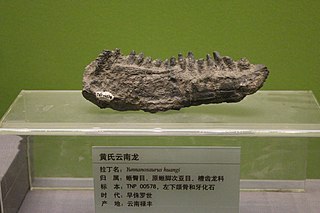
Yunnanosaurus is an extinct genus of sauropodomorph dinosaur that lived approximately 199 to 183 million years ago in what is now the Yunnan Province, in China, for which it was named. Yunnanosaurus was a large sized, moderately-built, ground-dwelling, quadrupedal herbivore, that could also walk bipedally, and ranged in size from 7 meters (23 feet) long and 2 m (6.5 ft) high to 4 m (13 ft) high in the largest species.

Antetonitrus is a genus of sauropodiform dinosaur found in the Early Jurassic Elliot Formation of South Africa. The only species is Antetonitrus ingenipes. Sometimes considered a basal sauropod, it is crucial for the understanding of the origin and early evolution of this group. It was a quadrupedal herbivore, like its later relatives, but shows primitive adaptations to use the forelimbs for grasping, instead of purely for weight support.

Blikanasaurus is a genus of sauropodomorph dinosaur from the late Triassic of South Africa. The generic name Blikanasaurus is derived from Greek, meaning "lizard from Blikana". The species name cromptoni is taken from the surname of A.W. "Fuzz" Crompton, an American paleontologist who led numerous field expeditions in Elliot Formation outcrop localities in South Africa. Blikanasaurus is only known from partial hindlimb bones that were recovered from the lower Elliot Formation (LEF) in the Eastern Cape.

Coloradisaurus is a genus of massospondylid sauropodomorph dinosaur. It lived during the Late Triassic period in what is now La Rioja Province, Argentina. It is known from two specimens collected from the Los Colorados Formation of the Ischigualasto-Villa Unión Basin.
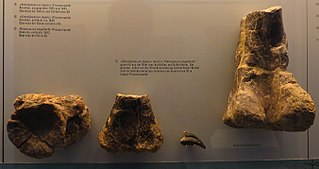
Gresslyosaurus is a genus of plateosaurian sauropodomorph dinosaur that lived during the Late Triassic period, around 214 to 204 million years ago, in France, Germany, Norway, Greenland and Switzerland.
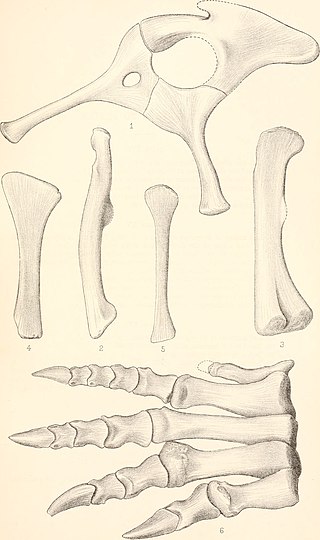
Gryponyx is an extinct genus of massopod sauropodomorph known from southern Free State, central South Africa.
Peter Malcolm Galton is a British vertebrate paleontologist who has to date written or co-written about 190 papers in scientific journals or chapters in paleontology textbooks, especially on ornithischian and prosauropod dinosaurs.

Plateosauridae is a family of plateosaurian sauropodomorphs from the Late Triassic of Europe, Greenland, Africa and Asia. Although several dinosaurs have been classified as plateosaurids over the years, the family Plateosauridae is now restricted to Plateosaurus, Yimenosaurus, Euskelosaurus, and Issi. In another study, Yates (2003) sunk Sellosaurus into Plateosaurus. Gresslyosaurus is alternatively considered its own genus or a synonym of Plateosaurus.

Riojasauridae is an extinct family of sauropodomorph dinosaurs from the Late Triassic Period. It contains the genera Riojasaurus and Eucnemesaurus. The Riojasauridae is considered a stem taxon, and is defined as "the most inclusive clade containing Riojasaurus incertus but not Plateosaurus engelhardti, Massospondylus carinatus, or Anchisaurus polyzelus". Geologic formations containing riojasaurid fossils include the Lower Elliot Formation of Orange Free State, South Africa, and the Los Colorados Formation, in La Rioja Province, Argentina.
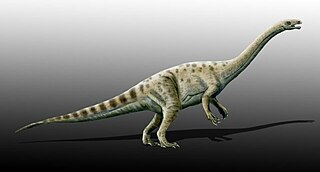
Massospondylidae is a family of early massopod dinosaurs that existed in Asia, Africa, North America, South America and Antarctica during the Late Triassic to the Early Jurassic periods. Several dinosaurs have been classified as massospondylids over the years. The largest cladistic analysis of early sauropodomorphs, which was presented by Apaldetti and colleagues in November 2011, found Adeopapposaurus, Coloradisaurus, Glacialisaurus, Massospondylus, Leyesaurus and Lufengosaurus to be massospondylids. This result supports many previous analyses that tested fewer taxa. However, this analysis found the two recently described North American massopods, Sarahsaurus and Seitaad, and the South African Ignavusaurus to nest outside Massospondylidae, as opposed to some provisional proposals. Earlier in 2011, Pradhania, a sauropodomorph from India, was tested for the first time in a large cladistic analysis and was found to be a relatively basal massospondylid. Mussaurus and Xixiposaurus may also be included within Massospondylidae.

Anchisauria is an extinct clade of sauropodomorph dinosaurs that lived from the Late Triassic to the Late Cretaceous. The name Anchisauria was first used Haekel and defined by Galton and Upchurch in the second edition of The Dinosauria. It is a node-based taxon containing the most recent common ancestor of Anchisaurus polyzelus and Melanorosaurus readi, and all its descendants. Galton and Upchurch assigned a family of dinosaurs to the Anchisauria: the Melanorosauridae. The more common prosauropods Plateosaurus and Massospondylus were placed in the sister clade Plateosauria.

Massopoda is a clade of sauropodomorph dinosaurs which lived during the Late Triassic to Late Cretaceous epochs. It was named by paleontologist Adam M. Yates of the University of the Witwatersrand in 2007. Massopoda is a stem-based taxon, defined as all animals more closely related to Saltasaurus loricatus than to Plateosaurus engelhardti.

The Melanorosauridae were a family of sauropodomorph dinosaurs which lived during the Late Triassic and Early Jurassic. The name Melanorosauridae was first coined by Friedrich von Huene in 1929. Huene assigned several families of dinosaurs to the infraorder "Prosauropoda": the Anchisauridae, the Plateosauridae, the Thecodontosauridae, and the Melanorosauridae. Since then, these families have undergone numerous revisions. Galton and Upchurch (2004) considered Camelotia, Lessemsaurus, and Melanorosaurus members of the family Melanorosauridae. A more recent study by Yates (2007) indicates that the melanorosaurids were instead early sauropods.
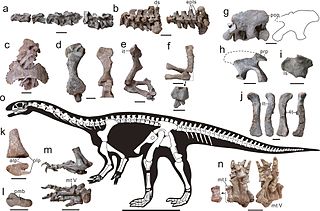
Xingxiulong is a genus of bipedal sauropodiform from the Early Jurassic of China. It contains a single species, X. chengi, described by Wang et al. in 2017 from three specimens, two adults and an immature individual, that collectively constitute a mostly complete skeleton. Adults of the genus measured 4–5 metres (13–16 ft) long and 1–1.5 metres tall. Phylogenetic analysis suggests that Xingxiulong is most closely related to its contemporary Jingshanosaurus, although an alternative position outside of both the Sauropodiformes and Massospondylidae is also plausible.

Unaysauridae is a clade of basal sauropodomorphs from the Late Triassic of India and Brazil.






























